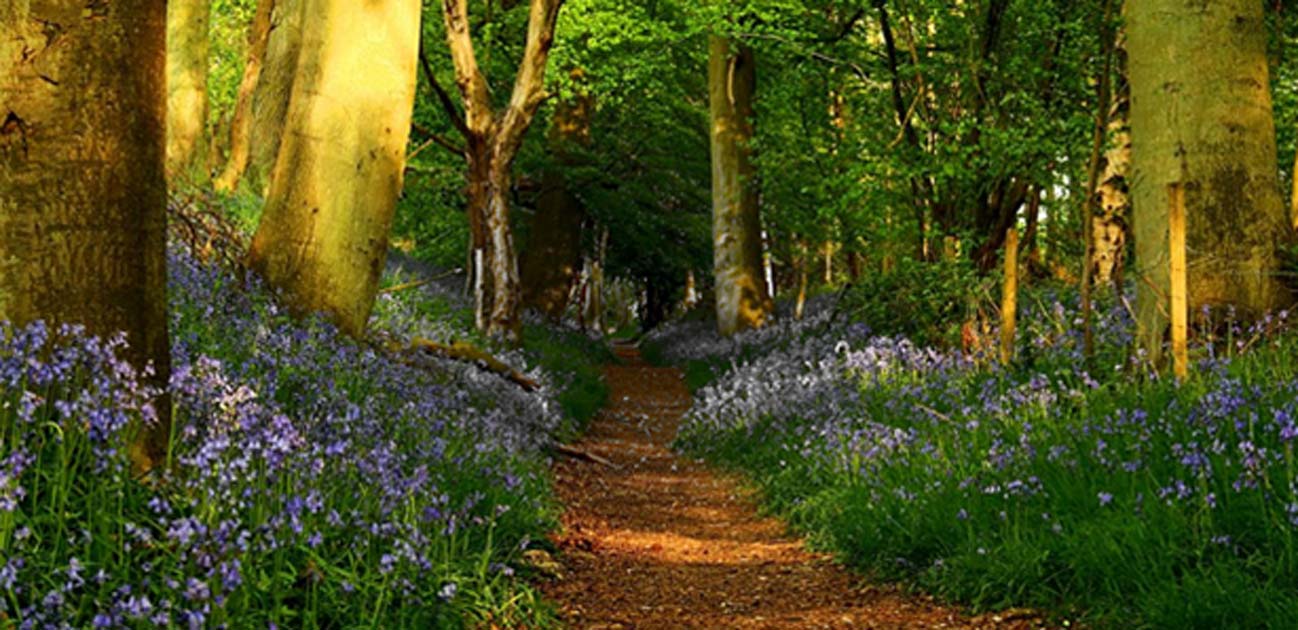What’s It Like to Travel the Oldest Road in the World? Think Dragon’s Blood and Neolithic Barrows
I have recently been following what may be the world’s oldest road. Remarkably, much of it still survives as an ancient track. Created around 5500 years ago, it predates the Egyptian pyramids by a thousand years and the first major urban civilization of Sumer in Mesopotamia by seven centuries. Those who built it were Stone Age people of the Neolithic period, before the invention of metal tools. Called the Ridgeway, it is 87 miles (140 kilometers) long and runs across central-southern England.

Map showing the Ridgeway in southern Britain, possibly the oldest road in the world. (© Graham Phillips)
The original road is thought to have been a dry trail, built up by piling earth and rubble into a raised cross-section, with a ditch to either side to prevent its flooding, and in parts it was actually paved. Even though there have been older pathways found elsewhere in the world, such as short log-covered tracks in India and the Middle East, the Ridgeway is the oldest known road to link separate and otherwise isolated settlements. The best preserved section joins some astonishing and very ancient monuments.
Uffington White Horse
At Uffington, around 60 miles (96 km) west of London, the Ridgeway passes an Iron Age hill fort dating from around 700 BC. Covering some eight acres, it is surrounded by a double arrangement of defensive earthen embankments and ditches that would once have included wooden stockades and gatehouses.

The Ridgeway running past Uffington, England. (© Graham Phillips)
Right next to it is a huge, 360-foot-long (110 meters) figure of a stylized horse, carved into the chalk rock of the hillside to be seen for miles around.
- The Mystery of the White Horse of Uffington
- 330 Years of Unknown History: The Oldest Road in America Finally Surfaces
- The Celtic Goddess Epona that Rode Swiftly Across the Ancient Roman Empire

The White Horse chalk carving. At least 2000 years old, it may have represented the Celtic goddess Epona. (© Graham Phillips)
Called the Uffington White Horse, it dates from at least two thousand years ago and its purpose remains a mystery. It may have depicted the horse goddess Epona, an important deity for the Celts who ruled Britain from around 2700 years ago until the Romans conquered the country in the first century AD.
Dragon’s Blood
Close by is Dragon Hill, a natural chalk mound with an artificially flattened top. This construction may be as old as the ancient road itself and was painstakingly created by a people using nothing but Stone Age tools. Again, its purpose is unknown but was probably used for ceremonial purposes. Legend holds that this is where England’s patron saint, St. George, killed a dragon – hence its name— and an area on the top where grass fails to grow is said to be where the beast’s blood fell.

Saint George Killing the Dragon (1435) (Public Domain)
Ancient Barrow of Norse Weapon-Forging God
A mile or so further along the Ridgeway to the west is what scholars believe to be Britain’s oldest surviving monument; it predates the arrival of the Celts from continental Europe by almost three thousand years. It is a Neolithic long barrow, a rock-chambered tomb covered with earth, its entrance flanked by four shaped standing stones, the tallest over ten feet high. The barrow is 43 feet wide and 185 feet long and is thought to have contained the remains of as many as fourteen bodies. They were probably the family of the high-status individuals, priests or chieftains, who ruled the area as long ago as 5300 years, and might have been those responsible for flattening Dragon Hill.

Wayland's Smithy, an ancient burial site over 5000 years old. (© Graham Phillips)
Like Dragon Hill, there is a legend attached to the site. It is said to have been the place where the Norse weapon-forging god once dwelt, and the structure is still named after him: Wayland's Smithy.
Böðvildr in Weyland's Smithy, John Gehring (1883) (Public Domain)
Enigmatic Avebury Stone Circle
Today the Ridgeway is a sandy track running through countryside unchanged for centuries, and, traveling southwestward, once it makes its way through the Wanborough Plain, various round hillocks can be seen to either side. Called round barrows or tumuli, these were the burial mounds of the people who probably built the largest stone circle in Britain. Standing beside the Ridgeway, Avebury Stone Circle is so large that it completely surrounds half the village of Avebury after which it is named.
With a diameter of over a thousand feet (over 300 meters), it dwarfs even Stonehenge, twenty miles (32 km) to the south. It originally consisted of around a hundred stones, ranging from between nine to 20 feet (2.7 to six meters) high and weighing as much as 40 tons. It was surrounded by a ditch some 30 feet deep and 60 feet (nine to 18 meters) wide, and an embankment 20 feet high and 40 feet thick (six by 12 meters).

Standing stones at Avebury, the largest stone circle in the British Isles. (© Graham Phillips)
Remarkably, this earthwork was not built for defensive purposes as the ditch is on the inside of the embankment, the opposite way round for a fortification. Like the stones themselves, the purpose of this huge undertaking is a complete enigma. Those who built it around four and a half thousand years ago were Stone Age people using nothing more than flint axes, bone shovels, and antlers for picks. More astonishing still, many of the massive blocks that made up the huge stone circle were somehow transported from quarries many miles away, without the help of draft animals, such as oxen or horses, by a people with no knowledge of the wheel. Then, in some way that is not fully understood, the builders hauled and planted the stones into upright positions. And the ringed embankment and ditch of over 3000 feet (914 meters) in circumference would have been an equally astounding achievement.
Neolithic Unsolved Mysteries
Archaeologists have estimated that the cutting, hauling, and erection of the stones for the stone circle, together with the digging of the ditch and building of the embankment would have taken almost forty million work-hours, and over 10,000 people toiling full time on the project for years on end, when the entire population of southern England was only around 30,000. The Avebury circle must have been of immense importance to the ancient people of Britain. There are estimated to have been over 4000 stone circles in the British Isles, most built between around 3000 and 1500 BC, and no one really knows why they were made. For whatever reason they were created, Avebury seems to have been the most important site of them all. Strange that it is not as famous as the smaller Stonehenge.
- Was Neolithic Silbury Hill Designed as a Welcoming Home for Omnivorous, Upwardly-Mobile Earthworms?
- Why was a Newly Discovered Irish Ringfort Surrounded by Bizarre Burials and Unfinished Jewelry?
- The Kjolur Route: Haunted Highway and Ancient Viking Shortcut in Iceland
Nearby, there is an even more enigmatic monument that dates from the same period as the Avebury circle. Silbury Hill, standing over 130 feet (40 meters) high and covering around five acres, is a completely artificial construction. Built mainly of chalk and clay dug from the surrounding area, the purpose of the mound is a complete mystery as excavations have revealed no signs of burials or any hidden chambers within. Why should Stone Age people have toiled for years to have built such a thing? Again, no one knows.

Silbury Hill, a 130-foot artificial mound near Avebury. Built around 2500 BC, its purpose remains a mystery. (© Graham Phillips)
The Ridgeway between Uffington and Avebury is around 18 miles (29 km) long, but this was only part of the original ancient road. It runs fifty miles (80 km) to the north-east. Some scholars have suggested that it also continued south-west, all the way to the south coast of Cornwall, well over a further 200 miles (321 km). The proposed route passes Glastonbury, which some suggest was the mystical Isle of Avalon; Brent Tor on Dartmoor, where stands one of the highest elevation churches in the country; and it reaches the sea at St. Michael’s Mount, an island in the extreme south-west of England that in legend is said to be all that remains of the sunken land of Lyonesse—Britain’s very own Atlantis.

Sunrise at St Michael’s Mount, Cornwall, England (Davidwogan/CC BY 3.0)
Graham Phillips is a British non-fiction author who has investigated historical mysteries for over three decades, and has appeared in many documentaries broadcast worldwide. Graham has been described as a “historical detective” and a “real-life Indiana Jones.”He is author of 15 books, including The Lost Tomb of King Arthur | GrahamPhillips.net
WATCH MORE! In The Templars and the Ark of the Covenant - Following Ancient Clues, Graham presents evidence that this remarkable relic really existed and was discovered by the crusader knights, the Templars, during the Middle Ages and brought back to Europe. From the war-torn Middle East to the quiet British countryside, Graham follows an ancient trail of clues in search of the mysterious lost Ark!
See author and researcher Graham Phillips’s exclusive webinar at Ancient Origins Premium.

--
Top Image: The Ridgeway in Grim's Ditch near Mongewell (Public Domain)



















Comments
Thanks for an interesting article. Here's a few points of feedback for you:
You might be confusing the route of the Ridgeway with the Michael Line first proposed by John Mitchell in the late 1960’s. The Greater Ridgeway actually goes from Lyme Regis in the west, keeping to the driest and highest ground, not via Glastonbury. It avoids the Somerset Levels as lowland places liable to flood. In the east, it goes as far as present-day Norfolk, and may have even have extended into Doggerland, when that was still above water.
The purpose of Silbury might not be a mystery at all, there's of evidence it was an astronomical observatory, deliberate built at the same time as Merlin's Mound in Marlborough, along the line of the equinox.
Carbon dating has shown that the mounds pre-date the bodies found there by hundreds or thousands of years. So they are unlikely to have been built as tombs.
It also perpetuates a myth to talk about "hill forts". These hill-top enclosures were far too big to have been effective military sites. The more mundane and peaceful fact is that these were used as places of rest and overnight safety for Ridgeway travellers with their animals and trade goods for thousands of years. Only on rare occasions in all those years were there ever any military events, like pitched battles between local Brits and mercenary Saxons. A mere blink of an eye in the life of the Ridgeway.